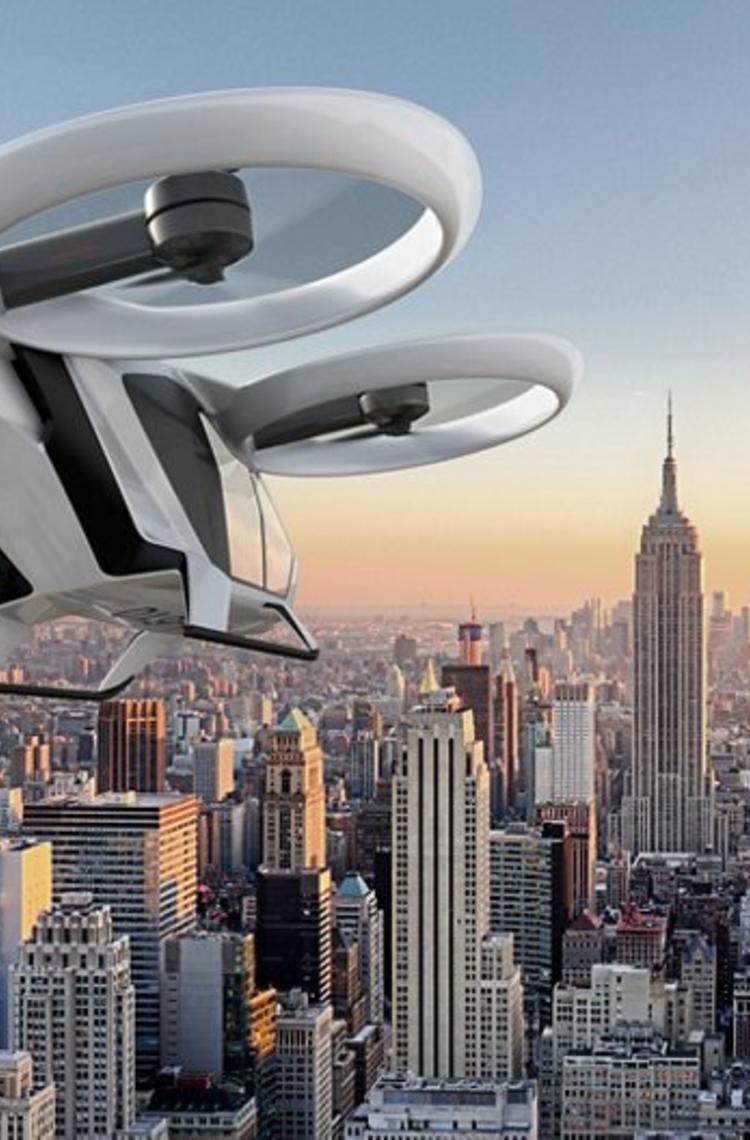Increased urbanisation is pushing our cities’ transport systems to the limits, costing valuable time and money. Airbus believes the solution lies in the sky. From flying vehicles to helicopters on demand, its portfolio of ground-breaking projects is helping to make urban air mobility a reality.
City streets are often a blur of movement: cars, trucks, buses, trams, scooters and bicycles all jostle for space, trying to make their way from A to B as quickly as possible. Sometimes, though, that motion grinds to a halt. As traffic jams grow, frustration rises, time is wasted and money lost. Getting around can quickly become a nightmare. Airbus wants to fix this.
Instead of looking at ground level, it is focusing its attention on a part of the city that remains congestion-free: the sky. “Imagine a world in which city travel is faster, safer, more reliable and more stress-free. Adding a third dimension to urban transport networks would revolutionise the way we live,” says Mathias Thomsen, General Manager for Urban Air Mobility at Airbus. “Streets would be safer, air pollution would be cut dramatically and we would have more free time.”
Thomsen is overseeing several urban air mobility projects at Airbus, from on-demand helicopter rides to shared flying vehicles and delivery drones. If that sounds like science fiction, the company is building on currently viable technology and plans to flight test a single passenger demonstrator as early as the end of this year.
Solutions to the urban mobility problem are certainly required. Urbanisation is a dominant trend around the globe and by 2030, more than 60% of the world’s population will be living in cities, stretching struggling ground transportation networks even further. In the EU, traffic congestion currently costs almost €100 billion a year. By 2030, it could be closer to €300 billion. American drivers lose an average of 42 hours a year in traffic jams. “We can’t keep overloading our roads,” says Thomsen, “but what we can do is take advantage of the space above us.”

Autonomous city flight
Airbus has already carried out a successful trial in São Paulo of its helicopter ride-hailing service Voom, which aims to ease congestion by making helicopter travel more accessible and affordable. Elsewhere, teams from Silicon Valley to Europe and Asia are working to create entirely new vehicles. CityAirbus is an electric vertical take-off and landing (VTOL) vehicle for up to four passengers, while Vahana aims to create a similar mode of transport for individual travellers or cargo transport. In Singapore, the company is working with the country’s National University on the Skyways project to test a parcel transport system using autonomous drones.
While each mission has its own individual requirements, Thomsen says there is an overlap of several core technologies Airbus is developing. “Quite simply, in today’s environment, any new solution has to be electrically driven, so batteries and charging stations are indispensable. Vahana and, eventually, CityAirbus will be autonomous to help facilitate safe operation in busier airspace, making reliable sense-and-avoid technology an important aspect. And mass-produced lightweight composite structures will enable cost-effective vehicle construction across large scales.”
New possibilities for urban planning
Alongside these engineering and manufacturing hurdles lie an array of other challenges to overcome. New vehicle types require certification, pilot training and air space regulation. Airbus is also working on consumer-facing tools, air traffic management systems and how to integrate the necessary ground infrastructure, such as charging stations and places to get on and off, into existing cityscapes.
“We’re already discussing some of these topics with a number of city authorities and they are very excited about the possibilities,” says Thomsen. “When you start thinking vertically about urban development it opens a whole range of new opportunities, from modes of transport to revolutionary building design.”
But is the public ready to fly through cities in autonomous vehicles? “It will certainly take time for this to be accepted, but we are confident. Airbus is a trusted name around the world and safety remains our number one priority,” answers Thomsen. “The reception to our air and ground concept Pop.Up at the Geneva Motor Show earlier this year was extremely positive. I think we’ll soon be seeing self-driving vehicles on the road on a regular basis. Eventually, autonomous transport, on the ground and in the air, will become part of everyday life.”
For now, though, Airbus is focusing on continuing to lay the foundations for an entirely new industry. “Nobody has ever done anything like this before, so it’s a learning curve. We expect to learn a lot from the projects we are putting in place now, which are just the beginning of a new generation of urban mobility.”
Geoff Poulton
